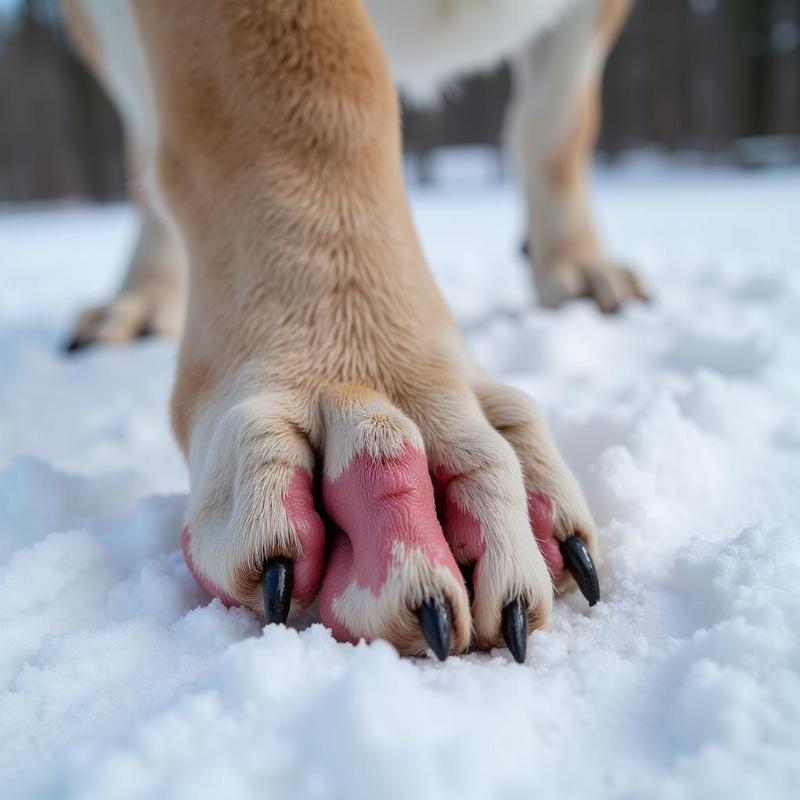If your dog starts limping in cold weather, you’re not alone. Many dog owners in the US notice their furry friends experiencing mobility issues during colder months. This can be due to a variety of reasons, from simple stiffness to more serious underlying conditions exacerbated by the cold. Understanding why your dog is limping in cold weather is crucial to providing them with the proper care and ensuring their comfort and well-being.
Why Does My Dog Limp More in Cold Weather?
Cold weather can exacerbate existing joint pain, particularly in dogs with arthritis or other orthopedic conditions. Just like humans, cold temperatures can cause stiffness and discomfort in joints. For dogs with arthritis, this can lead to increased inflammation and pain, resulting in a noticeable limp. Even dogs without pre-existing conditions can experience temporary stiffness in cold weather, leading to a temporary limp that resolves as they warm up. Muscle strains and injuries can also become more painful in the cold.
 Dog Limping in Cold Weather
Dog Limping in Cold Weather
Common Causes of Dog Limping in Cold Weather
Several factors can contribute to dog limping in cold weather. Here are some of the most common causes:
- Arthritis: Cold weather can worsen arthritis symptoms, leading to increased pain and limping.
- Hip Dysplasia: This genetic condition can be more painful in cold weather due to joint stiffness.
- Muscle Strains/Tears: Existing injuries can become more painful and pronounced in cold temperatures.
- Paws Injuries: Walking on icy surfaces or exposure to road salt can irritate or injure paws, causing limping.
- Reduced Blood Flow: Cold temperatures can constrict blood vessels, reducing blood flow to extremities and causing discomfort.
How to Help a Dog Limping in Cold Weather
If you notice your dog limping in cold weather, there are several steps you can take to help:
- Keep them warm: Use a dog coat or sweater, especially for short-haired breeds or senior dogs.
- Limit exposure to cold: Keep walks shorter during extremely cold weather and avoid prolonged exposure to icy or snowy surfaces.
- Provide a warm, comfortable bed: A cozy bed can help soothe stiff joints and muscles.
- Massage: Gentle massage of the affected area can help improve circulation and reduce stiffness.
- Pain relief: Consult your veterinarian about appropriate pain relief medications for your dog.
- Paw protection: Use dog booties to protect paws from cold, ice, and road salt.
When to See a Veterinarian
While some limping may resolve on its own, it’s important to consult with your veterinarian if your dog’s limping is severe, persistent, or accompanied by other symptoms like whining, swelling, or loss of appetite. Your vet can diagnose the underlying cause of the limp and recommend the best course of treatment. This may include medications, physical therapy, or other interventions.
Preventing Cold Weather Limping in Dogs
Here are some proactive measures to help prevent your dog from limping in cold weather:
- Maintain a healthy weight: Excess weight puts extra stress on joints, increasing the risk of pain and injury.
- Regular exercise: Regular, moderate exercise helps keep joints flexible and muscles strong.
- Joint supplements: Consult your veterinarian about joint supplements that may be beneficial for your dog.
- Warm-up before exercise: Just like humans, dogs benefit from a warm-up before strenuous activity, especially in cold weather.
- Paw care: Regularly check your dog’s paws for cuts, cracks, or irritation.
Conclusion
Dog limping in cold weather can be a sign of discomfort or a more serious underlying condition. By understanding the potential causes, providing appropriate care, and taking preventative measures, you can help your furry friend stay comfortable and mobile throughout the colder months. If you’re concerned about your dog’s limp, don’t hesitate to contact your veterinarian for professional advice.
FAQ
- Why does my dog limp sometimes but not always in cold weather? Cold weather can exacerbate underlying conditions like arthritis, making the limp more noticeable.
- Can cold weather cause permanent limping in dogs? While unlikely, untreated injuries or conditions worsened by cold weather can lead to long-term problems.
- Are certain dog breeds more prone to cold weather limping? Larger breeds and those prone to hip dysplasia or arthritis are more susceptible.
- What are the signs of paw injuries in cold weather? Look for redness, swelling, cracking, or bleeding on the paws.
- What type of dog booties are best for winter? Choose booties that are waterproof, insulated, and have good traction.
- Can I give my dog human pain medication for limping? Never give your dog human medication without consulting your veterinarian.
- Is massage helpful for dogs with arthritis? Gentle massage can provide some relief, but consult your vet before starting any new therapy.
Related Articles
- why do dogs legs shake
- is it bad for dogs to run on concrete
- how to know if concrete is too hot for dog
- dog doesn t want to walk
- can you use vaseline on dogs paws
Beautdogs.us is your premier resource for comprehensive dog care information, breed-specific insights, and top-quality product recommendations. Whether you’re a new dog owner or a seasoned expert, Beautdogs.us empowers you to provide the best possible care for your beloved canine companion. We offer expert advice on everything from nutrition and grooming to training and health. Connect with us today for personalized support! Email: [email protected], Phone: +1 501-555-7529. Visit Beautdogs.us for more information.